What winning the HCA Trainer of the Year Award means to me – by Neill Mapes
13th May 2019 | OUR STORIES
 Neill Mapes was awarded HCA/Marsh Trainer of the Year 2019, receiving his award at the HCA Annual Conference in March 2019. Neill has made the decision to gift half of his award money to the HCA in order to give support to a young craftsperson and the other half to his apprentice, Teresa Bailey, to buy her some tools. From all at the HCA we would like to thank Neill for this kind gesture.
Neill Mapes was awarded HCA/Marsh Trainer of the Year 2019, receiving his award at the HCA Annual Conference in March 2019. Neill has made the decision to gift half of his award money to the HCA in order to give support to a young craftsperson and the other half to his apprentice, Teresa Bailey, to buy her some tools. From all at the HCA we would like to thank Neill for this kind gesture.
Neill writes:
I’m very humbled to have won this award. It really does mean a great deal to me. I’ll try and explain why.
My love for British woodlands and woodland crafts began way back in my childhood. Many influences, over the intervening years, have given woodland crafts a deep meaning to my life, sustaining me through some of the darker times. More than I could have realised. It’s been a long journey to the awards.
My extended family were a major influence. My maternal grandfather Clarry Tedd and my uncle Bryan Tedd worked in the silver, electroplating and silver engraving trades. Distant ancestors from Huguenot descent also worked in silversmithing and furniture manufacture, whilst many of my female relatives were also gifted in clothes and wool crafts. My great aunt was a dress maker in Paris. On my father’s side of the family, my great uncle created a Welsh stick chair in the Arts and Crafts style, which the family treasure.
My father was a designer of cutting tools. His work touched many of the car and aviation businesses in Britain with some of his designs being used to construct Concorde. His technical drawing was exemplary. He also won an award which makes me very proud.
In 1964 my family moved from Birmingham to Tenbury Wells in sleepy South Shropshire. My time playing in this area gave me a love of the copses, woodlands and orchards. One particular hazel coppice (sadly now built upon) gave me an understanding of how they grew: tall rods stretching to the sky. Being under the canopy of trees was very special and protecting. These moments have stayed with me for life.
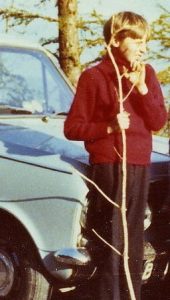

As far as I can remember, working with timber has always held my attention. Early days of building dens and playing in the countryside felt right. Another great influence was the Scouting movement, building structures with large pine poles and ropes, outdoor cooking, camping and building ‘benders’ with hazel rods. I attended Burford primary school, where nature and growing vegetables were a big part of the school life.
An early memory of woodcraft was seeing barrel makers ‘coopers’ whom my father and I stopped to watch through big double doors. Every craftsman would stop and put down their tools; this memory has stayed with me. Why would they do that? That question has formed part of my view about crafts – show everything… hide it and lose it!
1970 was the year I passed my 11+. I was the only child from the school to be accepted at Ludlow Grammar School. I didn’t find academic schooling easy. I came to realise that the arts and crafts were more fitting in my life and I excelled at woodwork, although this could have been knocked out of me, literally, by my first wood working teacher who was a tough rugby coach. I remember asking a question at the wrong moment and got bashed on the head with a 2 by 2 piece of wood. Why that didn’t put me off woodworking I don’t know! Twelve months later a new teacher arrived – Mr Charlton – a very tall, bearded, gentle giant of a man! He really made classes exciting. His rustic furniture was my first introduction to working with timber in its natural raw state. We were also allowed to mill metal and turn bowls on a graduate lathe – I loved those days. I don’t have anything left of those early days of making. Table, bowls, copper enamelled panel, and even a bird box. Being allowed to design was magical.
Mr Charlton’s love of technical drawing wasn’t new to me as my father was good at this too. Using just a pencil and ruler to draw was something I enjoyed. I took my O-levels and got A+ in woodwork. I won an award at school for this. I also enjoyed art as well – other subjects not so well … but I ended up with 6 O-levels.
My favourite subject I hoped to continue to A-level, but this is where life has a habit of shutting doors on us. I was the only student who wanted to take Woodwork and Craft at A-level, the head master refused this. I had considered going to a John Makepeace furniture making course, however an A-level was a requirement. My parents had suggested an apprenticeship in stone carving at York Minister. So I had to make a choice; I decided to take Art, Geology and Physics.
I had briefly thought of a career as a cartographer. During my A-levels the head master kept my oil painting of trees in his office. During A-levels I was involved with stage and scenery construction; making models of stage productions I thoroughly enjoyed. I have enjoyed stage shows to see the scenery construction, as well as the event itself.
After A-levels I gained a place at Shrewsbury Art College. Here I was introduced to graphic arts, life drawing, pottery, photography and on a Wednesday afternoon, the chance to use the wood working workshop. I thought I had struck gold and wanted to join the furniture making course once my foundation art course was finished. I was told I couldn’t, as the course was full for the next two years – another door shut.
I applied for Arts degree courses at Birmingham, Wolverhampton and Coventry. I wasn’t successful – I don’t think my heart was in it. So here life took a different turn, with both Art and Woodwork closed to me. I ended up taking several jobs – one in a food factory and ended up moving back to Shrewsbury working for Safeway food retailers as a management trainee. One hundred hours a week for £40 a week was soul-destroying. This was the late 1970s, the winter of discontent and, still very vivid in my memory, this formed my view of the world.
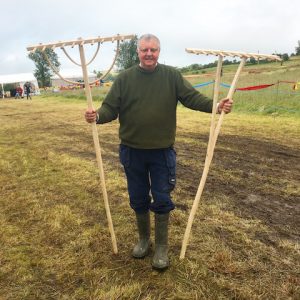
Neill with traditional ash hay rakes
I applied for a better job in the Fire Service, hoping I could find a way life. As you could imagine, sometimes this job was very stressful, punctuated with moments of joy and exhilaration when calls went well. Part of my respite from incidents was returning to the natural world. Volunteering with Wildlife Trusts and the then fledgling organisation, the Greenwood Trust (GWT), I attended hedge laying, coppicing, tree felling, and dry-stone walling courses, and gained a huge amount of knowledge. Seeing much of the timber from the hedgerows being burnt spurred me to start thinking about the way small round timber could be used. Here I bought my first basic carpenter’s kit to make small stools and chairs. I didn’t have access to a workshop but used the garden of the house I lodged in.
By the late 1980s I was occasionally volunteering at the Green Wood Trust. Here I met Gerwyn Lewis. His knowledge, expertise and drive were a major influence and they were very memorable and magical times. After one timber framing course, Gerwyn asked if I would be interested in being his apprentice. I would have jumped at the chance, had I not been in another job, and married with a child on the way. I couldn’t accept. I shouldn’t have regrets but that felt like an important opportunity missed.
I continued volunteering with GWT and latterly with The Small Woods Association. I attended more courses and continued making for pleasure, at home in a small shed/workshop I’d built at the bottom of the garden.
Throughout my further Fire Service career, I was given the opportunity to counsel young people on the effects of ‘playing’ with fire. Seeing the effects of the damaged caused by fire was a humbling time.
I moved from firefighting and chainsaw trainer to fire training and fire safety departments. I was the first dedicated Schools Fire Safety Officer, working in partnership with Telford and Wrekin, inspecting all schools in the borough within a 15 month period. During my time in the training department, I was trained by the Swedish fire service in dealing with compartment fires.
I’d struggled with depression and back injuries. Certain incidents had left an effect on me. A collapsed building, the effects of lightning striking a building close to where I was sat on a roof of a house, dealing with a fire caused by a previous lightning strike. They say lightning never strikes twice. It came very close.
One incident had a profound effect on me. A house fire where a mother and 2 young children tragically lost their lives. I still think about that incident, an incident that was to come back into my life more 20 years later. I’ll come back to this story later.
I ended up leaving the service after an industrial tribunal; the case ended up having a national impact on the Fire Service pension scheme. To this day I felt I was being used to achieve these changes. I was left in a very distraught state through the culmination of dealing with family illnesses, suicide, several deaths within my family that included my father, loss of my career, marriage break-up and subsequent loss of my home. In a matter of months everything had gone, including my self-respect. I don’t know where the strength came from to continue in life. Knowing I had to be there for my daughters was so important to me.
The support from my siblings, my daughters and my mother were key. But the support of close friends who had been through similar events in their lives, really helped. One friend in particularly, Granville Reeves, who was a woodsman, was a great support and friend. He and others encouraged me to start a business in woodland crafts and art work. The only way I could see forward was to start making and selling.
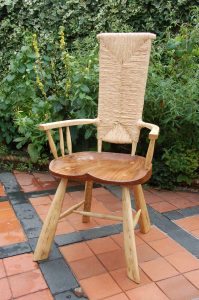
Chair made by Neill
This moment of revelation, the light bulb moment, was during these dark times. Going to the trees and woodlands gave me hope. I look back over the earlier part of my life. I had a 30 year apprenticeship. I would sit and carve spoons, badly in the early days, I might add. This is really something I would advocate. Carving spoons is a good meditative craft and after several hours of carving, I can feel very mentally refreshed. Whatever I worried or felt anguished about, was gone. I felt a lot calmer and more at peace.
Chairmaking was also very important too. The use of a shavehorse and turning on a pole lathe really put me back in touch with the natural world and landscape. It is these days that helped me decide that starting an arts and craft business was going to be an adventure. Hard work and exciting too. It gave me self-respect and some control over my life.
Attending local events, shows and galleries, gave me hope and confidence because people starting buying what I made. It wasn’t long before The Small Woods Association offered me the chance to teach and tutor on projects and courses after I took a teaching qualification.
Working with groups of people who also struggled in their lives gave me a sense of purpose. I empathised greatly with them and built a rapport, helping them through my passion of woodland crafts.
It’s here where past career came to the fore again. I was tutoring a project for the SWA and a man who attended was really struggling in life. I realised it was his family that was involved in the house fire I had attended. At first I didn’t want to admit I had been there. He told me how the incident had completely changed his life. I sat down quietly and told him my part in trying to rescue his family members. There was a silence and he told me he wanted to talk to the rest of his family. The next day he told me his family were pleased to have been able to thank someone who had been involved. What he did not know was how it had affected me. The death of a young child and then a day or so later, carrying my newly-born daughter home was one that will live with me forever. Life is very precious. I made it my mission to help who I could. However small that help was.
Building up the business, I attended national shows, such as the Association of Professional Foresters (APF), countryside shows and even Christmas and food festival events. During these times I built up a social media presence and became admin on several Facebook greenwood and woodworking pages. Being a member of The Association of Pole Lathe Turners and Greenwood workers (APT) brought me into acting as participant and judge at several events, particularly the Bodgers’ log to leg races. I was continually supplying shops and galleries, and also took on commission sculptural art pieces for several Shropshire based organisations and councils.
A small woodland craft business needs many strands of income to work. Chairs, stools, spoons, cutting / serving boards and hand carved bowls formed part of my income. So did teaching courses, as well as producing digital art works on canvasses etc.
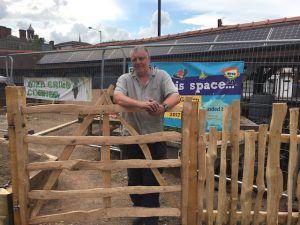
Cleft oak fence and gate created by Neill for the Shropshire Wildlife Trust headquarters in Shrewsbury
I worked for organisations such as Shropshire Wildlife Trust, Corndon and Stiperstones Landscape Partnership, Severn Gorge Countryside Trust and other county Wildlife Trusts, as well as SWA and other agencies such as the National Trust. This gave me a reputation of getting a job done.
About two and a half years ago I was approached by Richard Thomason (SWA Training Manager), to teach on a new project: ‘Building Better Opportunities’ – Build a bench. I was now part-time employed as well as self-employed. I’m very passionate about this project. Having been through tough times, I understand how tough life can be. Losing one’s self-respect and confidence is difficult to bounce back from. For me, craft work and a fledgling business gave me purpose in life. What I bring to the project is offering small stepping stones to people. Through making using basic greenwood craft skills, in natural surroundings, is a way to just be. To offer caring, understanding, kindness and empathy is key.
Everyone can make. It just needs a gentle approach offering support, guidance and encouragement. I found spoon carving very therapeutic; the concentration needed to carve took me away from the problems that filled my mind. The same for pole lathe turning too. My mantra is to send everyone home with a smile. To see someone smile, having just made something for the first time is a wonderful experience.
In my mind, I just think ‘LESS PILLS, MORE CRAFT’. Not without doctor’s advice, but it worked for me.
The key role of a tutor is emotional intelligence, a nurturing role. To hear comments like “I can’t wait to get here” has echoes of my own experience. The SWA site has a very special feel, something I hope is never lost. Tutoring is tiring and sometimes stressful but always exciting. I’ve dedicated many years of my life to helping people in all I’ve done.
The award means everything to me. If I can help someone in the craft that given me so much, then the hard work and turmoil I’ve gone through has been worthwhile.
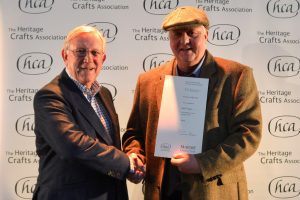
Neill being presented with his award by Nick Carter, Marsh Christian Trust.
I started out asking a SWA colleague, Julia Allinson, if it was possible to apply for an HCA award for our Heritage Crafts Trainee, Teresa Bailey. This was to try and find a way to get funding for tools. Little did I realise that both Teresa and Julia had applied on my behalf for the Trainer of the Year award.
To be nominated was wonderful. To be shortlisted and asked to attend the awards was amazing. A sense of ‘no, it won’t happen’, ‘I’ll just turn up and enjoy the day was all I could hope for. Both Teresa and I were honoured to be asked to attend the HCA event in London. My brother, who has witnessed my journey, was there to see me receive the award. I felt like I’d come home in that room of contemporary craft makers.
I’m indebted to those who have helped me get to here. Truly humbled. Craft has the propensity to heal, to encourage and to inspire. Society must not underestimate a person’s need to create in their lives.
I urge everyone to make.
Neill Mapes
